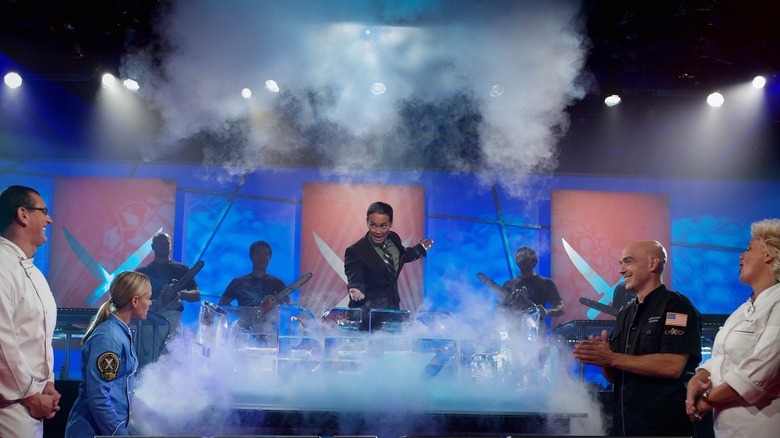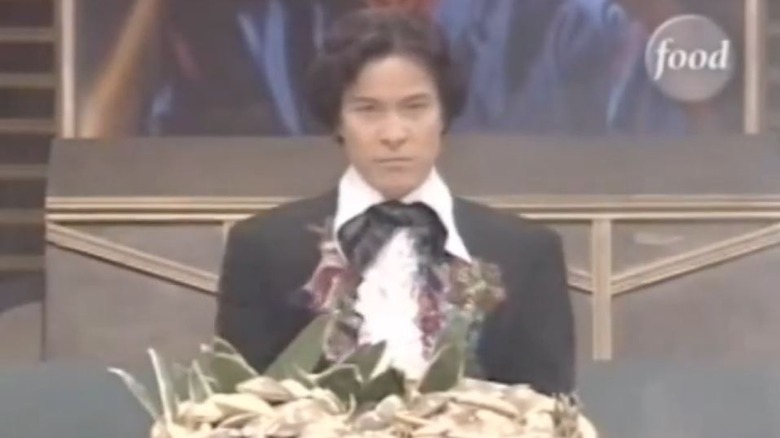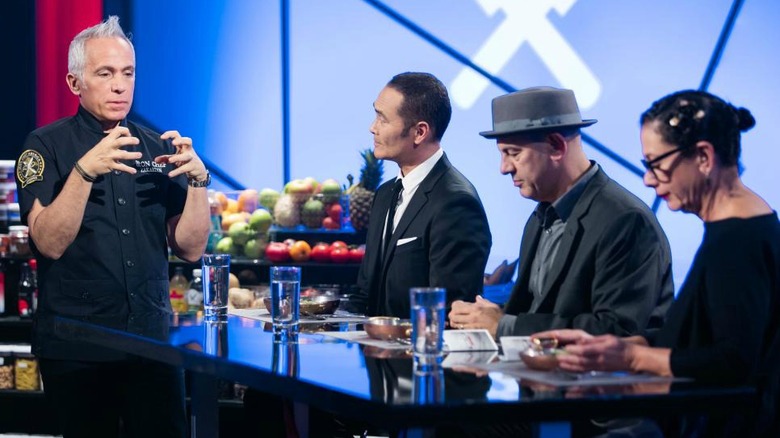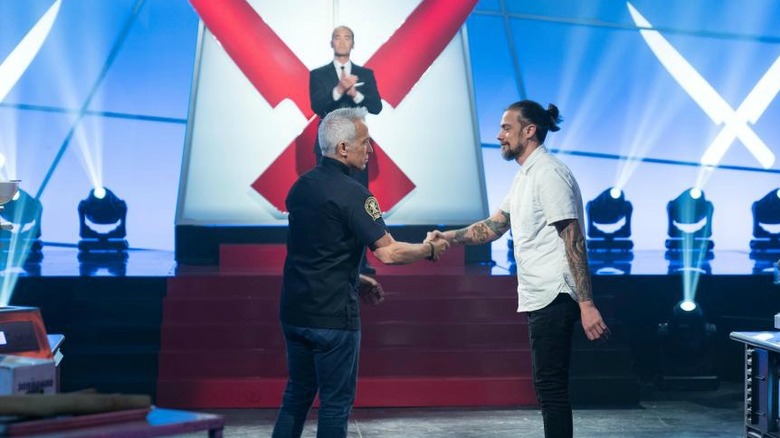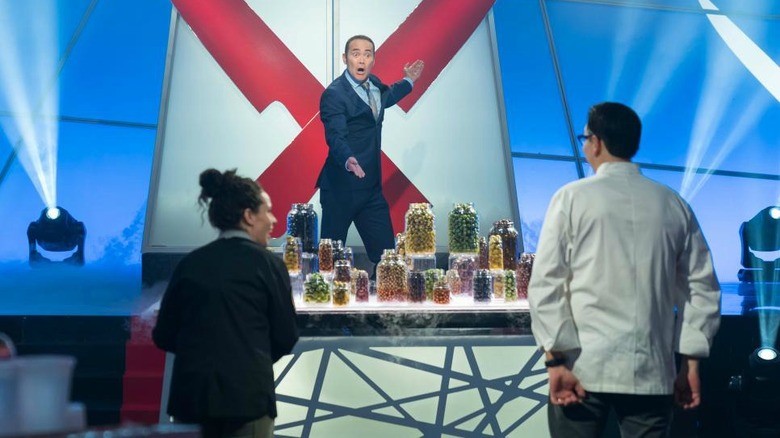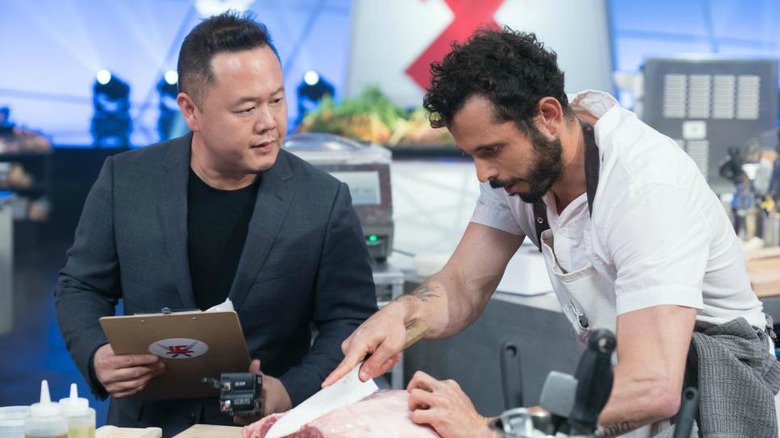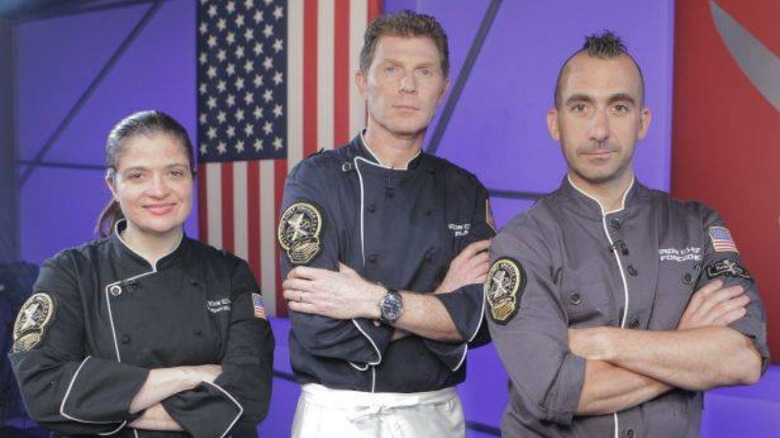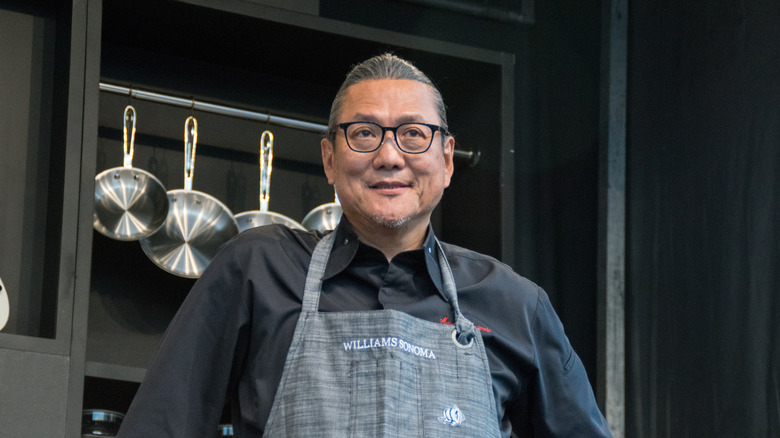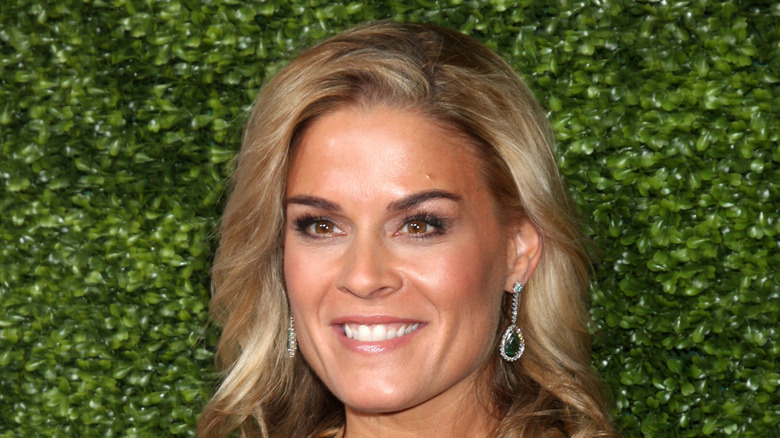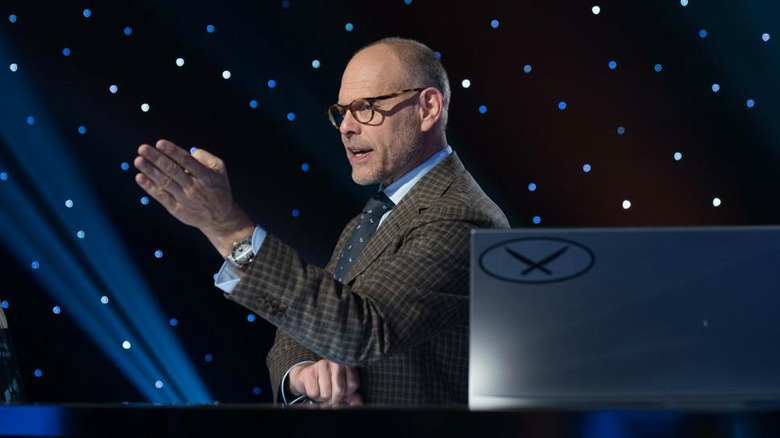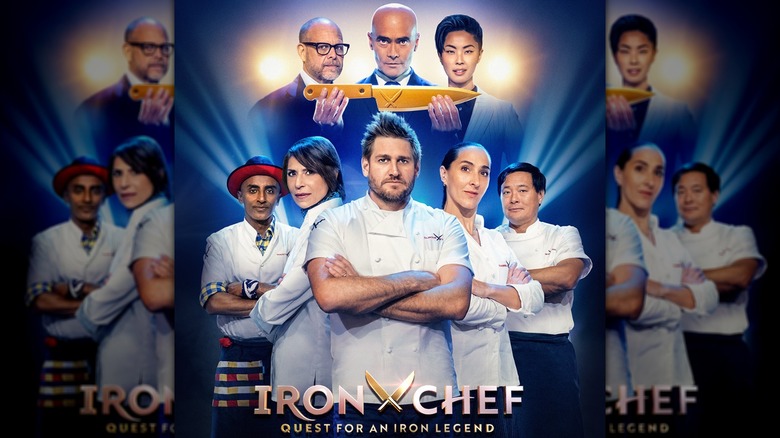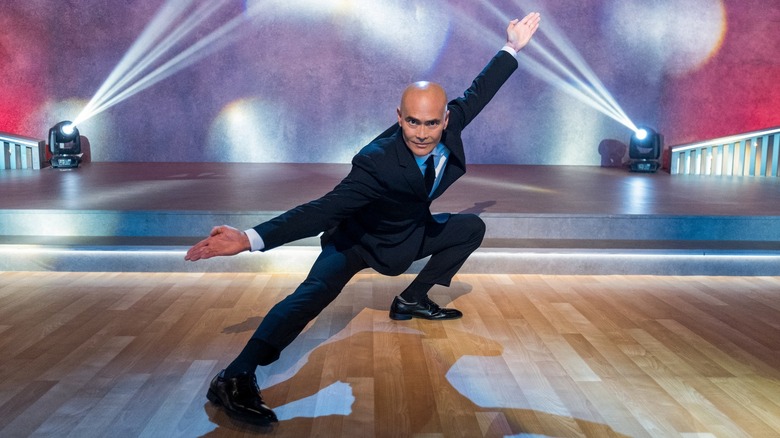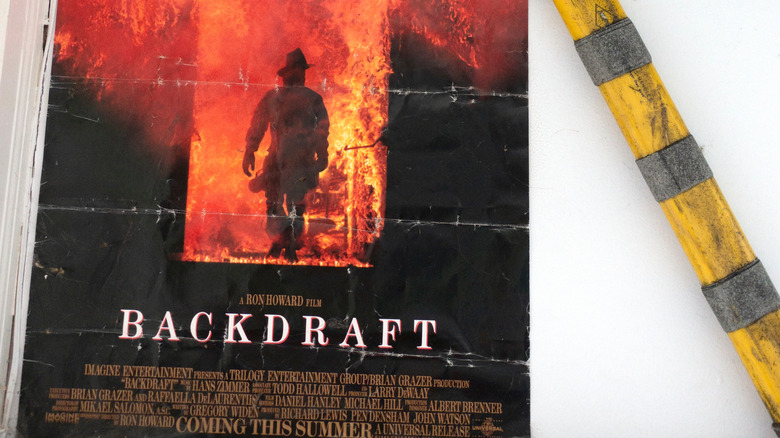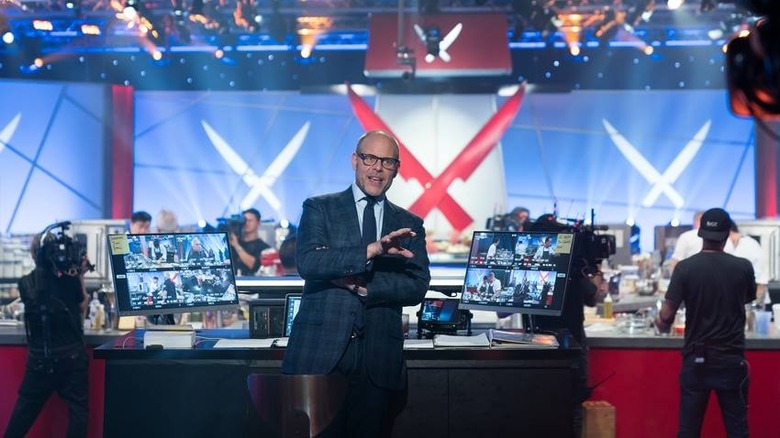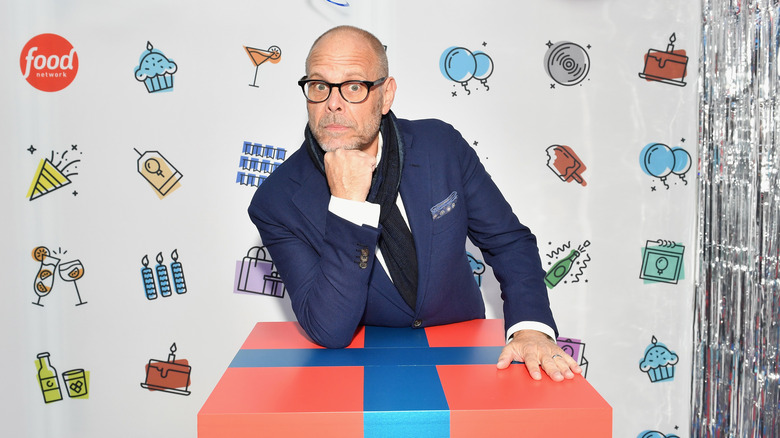The Untold Truth Of Iron Chef
Many an American movie or television program originated in another country. "The Office," "The Departed," and "House of Cards" are just a few. Food Network drew its inspiration from a hit Japanese show to mold an American version. But adapted foreign ideas aren't always a sure hit. "Iron Chef" had a cult following prior to the American version hitting the airwaves. The shows are similar but also vastly different. So what was really happening? Let's take a look at "Iron Chef" and break it all down.
Kaga once played Jesus
The ruse wouldn't work in Japan. Takeshi Kaga was an actor, and everyone knew it. Kaga was best recalled for playing Jesus in the Japanese production of "Jesus Christ Superstar." He also played Tony in "West Side Story." He wasn't a movie star, but it's clear that he wasn't an unknown, either. Part of the flair that caught American audiences by surprise was the over-the-top costuming Kaga wore. Often in a cape, Kaga played up his chairman with a stage actor's flair. To the unknowing U.S. viewers, he came off as a crazy Japanese guy with a ton of money who loved eating soft shell turtle.
Iron Chef USA
"Iron Chef America," the Food Network re-imagining of the Japanese original, actually wasn't the first time an American production company tried to remake the show. The original "Iron Chef" took itself seriously: it was about the food and the presentation. Somehow, lost in translation, "Iron Chef USA" didn't get that message. William Shatner played the chairman. "Hokey" and "Over the Top" are Shatner's middle names, and Ole Bill came through in spades. Rather than a quiet, subdued atmosphere, "Iron Chef USA" was filmed in Las Vegas and it sounded like there was a five-drink minimum to loosen up the crowd.
"Iron Chef" featured actors who had a knowledge of food and provided color commentary on the dishes. By contrast, the "Iron Chef USA" judges were people you'd never heard of who were allegedly famous. It was as if "Dancing With The Stars" was renamed "Dancing With Names You May Have Heard Before," except you definitely wouldn't have heard of the "Iron Chef USA" judges. Mercifully, Shatner's fluffy-shirted performance and incredibly bad line delivery only lasted two episodes.
Matchups are done in advance
Part of the mystique of "Iron Chef", both Japan and America, is the majestic rise of the Iron Chefs. After the pageantry, the challenger chef stands before the Iron Chefs and measures them up. Which will he choose? One with a similar cooking style? A chef with a different specialty? The chef only has a split second to decide! Except none of that happens.
The podium rising with chefs is recorded long in advance, either during the first episode of the season or before cooking actually begins. The challenger chef picks the Iron Chef weeks in advance of the taping. The only chef that rises up the day of the taping is the one who is being chosen — the other "chefs" are stand-ins that look similar to the Iron Chefs. For example, if the producers need a stand-in for Mario Batali, they just find another rotund redhead not doing anything that day. That makes sense, as all the Iron Chefs have other jobs and can't just show up for every taping and wait around for someone to pick them.
Chefs can pick their ingredients
Well, if the podium rising isn't real, at least the reveal of the secret ingredient is, right? Well ... kinda. On "Iron Chef America," both chefs have an idea of what the ingredient will be. Sometimes, it's as blunt as "it's either buffalo or bass"; other times it's literally decided between the chefs.
In addition to the available spices and seasonings, the chefs are given a $500 budget to spend on any specialty ingredients they want for their dish. Then they'll write different lists for each possible secret ingredient. But obviously those lists are different. The producers go out and purchase what the chefs need and when chefs show up at the taping, all they have to do is look at their ingredients to figure out what the "secret" ingredient is going to be.
The show is super fake
OK, but the rest of it is real, right? Well, you might want to sit down for this one. First, it's a television show. It's not a live sporting event or some spontaneous action captured and shared on social media. Sure, some actions will probably be repeated, like Iron Chef Morimoto and his competitor repeatedly reaching for an ingredient to get the timing and angle right. Before any cooking begins, the crew can spend up to an hour getting the required video of the Iron Chef, the challenger, the chairman, and Alton Brown. And once the cooking begins, the one-hour time limit seems to be more for television than anything else.
There's no rushing around as seen on TV, except specific hurried shots. Once the chef, Iron or not, presents the dishes to the judges, the actual presentation can be shot up to three times to vary the angle. The judging can take up to 45 minutes. So, what happens if you're batting second with your food sitting around for an extra hour? The sous chefs or sometimes even the producers just re-cook a fresh, hot meal! That's right, the judges aren't even tasting something prepared by the actual chef competing. A proposal for the name of the show: "Here's Two Chefs and Some Food They Stood By."
Bobby Flay's Iron Chef run
Of all the Iron Chefs, Bobby Flay is unique. He is an Iron Chef and appeared as a challenger on the original "Iron Chef." He had quite the experience. He cut himself and was electrocuted when water dripped to a wire on the floor and shocked him. But the most memorable action happened when he stood on the cutting board to encourage the crowd. That greatly offended Iron Chef Morimoto, who snapped that Flay "is not a chef," for disgracing the cutting board and knives by standing on them. Flay lost that matchup and it led to a real rivalry of sorts between the two chefs.
A grudge match between the two just had to happen, so it did. Flay returned to Japan to once again challenge Morimoto with spiny lobster as the secret ingredient. Flay got his revenge taking down the Iron Chef. The original match is seen as a turning point for both the show and chefs in general. "That's the moment that brought Food Network into pop culture," Flay said. Flay once said in an interview that he played up the brash New Yorker a bit for the Japanese crowd, but it worked. Both Flay and Morimoto became Iron Chefs on "Iron Chef America."
The empire of Morimoto
Masaharu Morimoto has made more of himself from "Iron Chef" than many of the other Iron Chefs. On the original "Iron Chef," the first Iron Chef was Kaishoku Michiba, who gave way to Koumei Nakamura for only a brief time. Morimoto followed them up as the Japanese show neared the end of its run. Coming all the way from Nobu in New York, Morimoto may not have been as well known to Japanese audiences, but he springboarded into super-chef stardom from there.
In addition to joining "Iron Chef America," Morimoto operates restaurants all around the world, including Disney Springs. (That's the former Downtown Disney, and it serves excellent meals, including street fare quick dishes. It was awesome, but I spent $38 on lunch for two, so bring your charge card.) He also licenses his own beer produced by Rogue Brewery of Oregon. He sells knives and grapeseed oil ... the guy is everywhere! And he can trace it all back to being on the original "Iron Chef."
Cat Cora's downturn
Unlike Morimoto, Iron Chef Cat Cora hasn't experienced the flood of success that sometimes comes with television fame. She's had the kind of luck reserved for gypsy curses. She burst on to the scene as the first female Iron Chef, and that got her a lot of exposure that led to some newfound fame and star power. But after the initial "Hey, it's Cat Cora!" died down, the wheels came off.
How bad has it been? Well, she got a DUI in 2012, divorced her wife of two years (and longtime partner before that) in 2015, her Disney restaurant Kouzzina closed in 2014, and her other brands aren't exactly getting rave reviews. To add insult to injury, a reality star dragged her name through the mud and said the two had a fling. And when she was on Iron Chef America she had a record of 21-12-1 and seemingly disappeared from the show without much fanfare.
In 2017, things got a bit more odd for Cora. According to an October 2017 filing, Cora sued Fatbird restaurant located in the hip meatpacking district of Manhattan, a restaurant she previously backed. The suit alleges that Cora is owed $400,000 plus a 10 percent equity stake of the joint. The Fatbird reviews were, sadly, about as great as her other establishments and by December 2017, the restaurant flew the coop for good and permanently closed. Good luck with that 10 percent stake...
It was never officially canceled
In Japan, "Iron Chef" premiered in 1993 and ran until 1999; it was still quite popular at the time of its end, but traditionally in Japan, TV shows will end while still generating ratings, unlike in the US where we beat every horse dead. "Iron Chef America," however, just sort of... stopped showing up. That led most to conclude that "Iron Chef America" was cancelled. In 2014, Food Network flatly denied "Iron Chef America" was being canceled, but there weren't any new episodes airing either.
A few years later, we finally learned what was happening. A new "Iron Chef" program premiered on the Food Network: "Iron Chef Gauntlet." Alton Brown served as the new "Chairman" but there was a twist — the show was just a limited series. Stephanie Izard won the six-episode competition, defeating the combined powers of three Iron Chefs to earn herself the title of Iron Chef. Which... doesn't mean a whole heck of a lot without a show to appear on, but hey, it's still technically not canceled, so she's got that going for her.
Finally, the show made yet another comeback in its original form in 2018 with a 10-episode season... but there's no word on if there's another season in the works.
Netflix debuted a new Iron Chef
"Iron Chef" is certainly the gift that keeps on giving. Four years after the curtain dropped on both "Iron Chef America" and "Iron Chef Gauntlet," the iconic cooking competition returned when "Iron Chef: Quest for an Iron Legend" premiered on Netflix in June 2022 (via USA Today). Much has remained the same, but there are several notable changes that host Alton Brown calls, "quite significant and crucial." One of those tweaks directly involves Brown, who is joined by co-host and Top Chef winner, Kristen Kish.
The Iron Chef roster has some new faces too, all of whom are among the culinary elite. The team includes Marcus Samuelsson, Gabriela Cámara, Curtis Stone, Ming Tsai, and Dominique Crenn, the first female U.S. chef to earn three Michelin stars. "It represents a global style and approach," Brown told USA Today. "It's fresh. I'm seeing stuff I've never seen. That's saying something."
The most significant departure from past "Iron Chef" iterations is in the competition itself. The Iron Chefs will participate in individual challenges, as per usual. However, at the end of the season, the highest-scoring challenger competes against all five Iron Chefs. If they beat the all-star team, they are awarded a new golden trophy. "If one lone challenger takes [the Iron Chefs] down, shame, SHAME!" said Mark Dacascos, who plays the Chairman. "But if the challenger can pull it off, then respect. Until a challenger chef wins the trophy, it shall stand" (via USA Today).
The chairman is actually an actor
You may not recognize the name Mark Dacascos, but you'll certainly recognize his face. Dacascos is a professional actor who has appeared in numerous movies and television shows, including "John Wick: Chapter 3 – Parabellum," "Agents of S.H.I.E.L.D.," and "Hawaii Five-O." But his most famous role is that of the Chairman, which he took on in 2004 with the debut of "Iron Chef America."
Over the course of nearly 20 years, Dacascos, who is also a martial arts expert, has used his unique skillset to turn the Chairman into one of the most defining and beloved parts of the show. "Being a son of two martial arts parents, I just thought it could be interesting to bring that martial energy," he told The Ringer. "In my mind, the Chairman loves martial arts, but oh, he loves cooking. And though he can't cook like this himself, he can bring that passion and the energy that he has. For him, he cannot vocalize enough how excited he is, so he physicalizes as well."
Dacascos' performance ratcheted up to a new level in the latest version of the competition, "Iron Chef: Quest for an Iron Legend." "In the old days, Mark was very serious," host Alton Brown told USA Today. "But he's managed to bring an absolutely lovable zaniness to The Chairman." This "zaniness" includes a new appearance, as Dascasos shaved his head for his role in "John Wick" and kept the more dramatic look for "Iron Chef."
Most of the original Iron Chef music is from an action movie
Despite ultimately being a friendly competition, "Iron Chef" has a certain dramatic quality to it — and only the right music can adequately capture that feeling. So, when looking for a properly intense soundtrack, "Iron Chef" producers chose to borrow from a dramatic film. Most of the music used in the original "Iron Chef" was adopted from the movie "Backdraft," according to The Takeout. The film, about firefighters tracking down an arsonist, was released two years before "Iron Chef" debuted.
The creative team behind the "Iron Chef" had good musical taste. The music for "Backdraft" was produced by Hans Zimmer, who would go on to become an Academy Award-winning composer. Some of his most famous works can be heard in films like "The Lion King," "Gladiator," "The Dark Knight," "Inception," and "Dune."
According to the "Iron Chef" IMDb page, the original show used three different songs from the film. The most notable was "Show Me Your Firetruck," which played during the intro and ending credits. Known as the "Iron Chef March," it became the show's de facto theme song. The other two "Backdraft" score pieces adopted by the show included "Burn It All," which was played as the challenger entered Kitchen Stadium as well as during the theme ingredient unveiling. "Fahrenheit 451" came on towards the end of the competition, during the presentation of both chefs' dishes and when the winner was announced.
Host Alton Brown admits he's playing a character
Fans who know "Iron Chef" host Alton Brown from his countless other television gigs might be surprised by the version of Brown they see on the cooking competition. He admitted to Eater back in 2010 that he's not his true self when hosting the show. "I'm a hybrid of myself. I'm not Alton Brown on "Good Eats," which is the real me," he said. "I'm my Iron Chef persona which is a little different. [...] I really don't know how I come off."
Staying in character is the least of Brown's concerns while hosting the hour-long program, however. Although he may look calm, cool, and collected, there's a flurry of activity going on behind the scenes. At any point in time during the competition, Brown is taking in information from at least four different screens: two television monitors showing all the camera feeds, a laptop with a database of ingredients, and an iPad to look up any additional information he may need in the moment. All this happens while he is taking direction from the producers through an earpiece.
Don't worry about him, though. "It's a kick. It's a rush," Brown told Eater. "Is there stress? Yes, but it's good stress. I dig that hour."
Alton Brown got into hot water with a controversial tweet
Alton Brown has had a long, successful run as host of "Iron Chef," but it hasn't been all smooth sailing off-screen. Most notably, the longtime Food Network personality found himself embroiled in controversy in November 2020 after posting several insensitive tweets comparing America's current political landscape with the Holocaust (via Eater). "So, when they move us to the camps, do you think they'll let us choose the state? I'm going to ask for Kansas because the sky is so gorgeous there... over the wheat." Brown wrote, following up with, "Do you think the camp uniforms will be striped, like the ones at Auschwitz or will plaid be in vogue?"
According to Eater, the tweets weren't meant to make light of the Holocaust, in which six million Jewish people were killed. Instead, it was Brown's bleak prediction of what he thought would happen to the U.S. if Donald Trump did not concede the 2020 presidential election. Nonetheless, many people were upset at the joking comparison to a genocide. According to NBC News, the nonprofit organization StopAntisemitism claimed Brown had "spat on the graves of six million Jews with his vile, atrocious comment!"
Brown quickly deleted the posts and issued an apology. He said, in part, that his intention was to "reflect how deeply frightened I am for our country. It was a very poor use of judgement and in poor taste" (via Eater).
